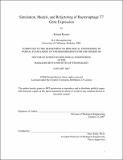Simulation, Models, and Refactoring of Bacteriophage T7
Author(s)
Kosuri, Sriram
Downloadthesis.final.pdf (7.789Mb)
Metadata
Show full item recordAbstract
Our understanding of why biological systems are designed in a particular way
would benefit from biophysically-realistic models that can make accurate predictions on the time-evolution of molecular events given arbitrary arrangements of genetic components. This thesis is focused on constructing such models for gene expression during bacteriophage T7 infection. T7 gene expression is a particularly well suited model system because knowledge of how the phage functions is thought to be relatively complete. My work focuses on two questions in particular. First, can we address deficiencies in past simulations and measurements of bacteriophage T7 to improve models of gene expression? Second, can we design and build refactored surrogates of T7 that are easier to understand and model?
To address deficiencies in past simulations and measurements, I developed a new single-molecule, base-pair-resolved gene expression simulator named Tabasco that can faithfully represent mechanisms thought to govern phage gene expression. I used Tabasco to construct a model of T7 gene expression that encodes our mechanistic understanding. The model displayed significant discrepancies from new system-wide measurements of absolute T7 mRNA levels during infection. I fit transcript-specific degradation rates to match the measured RNA levels and as a result corrected discrepancies in protein synthesis rates that confounded previous models. I also developed and used a fitting procedure to the data that let us evaluate assumptions related to promoter strengths, mRNA degradation, and polymerase interactions.
To construct surrogates of T7 that are easier to understand and model, I began the process of refactoring the T7 genome to construct an organism that is a more direct representation of the models that we build. In other words, instead of making our models evermore detailed to explain wild-type T7, we started to construct new phage that are more direct representations of our models. The goal of our original design, T7.1, was to physically define, separate, and enable unique manipulation of primary genetic elements. To test our initial design, we replaced the left 11,515 bp of the wild-type genome with 12,179 bp of engineered DNA. The resulting chimeric genome encodes a viable bacteriophage that appears to maintain key features of the original while being simpler to model and easier to manipulate. I also present a second generation design, T7.2, that extends the original goals of T7.1 by constructing a more direct physical representation of the T7 model.
Date issued
2007-02-02Department
Massachusetts Institute of Technology. Department of Biological EngineeringCollections
The following license files are associated with this item: